How to Make a Tropical Fruit Hat? 6 Easy Steps!
To make a tropical fruit hat, choose lightweight and colorful fruits, construct a sturdy base, design the layout, attach fruits securely, add decorative elements, and apply preservation techniques to maintain its appearance.
Here are some quick steps:
Craft a stunning tropical fruit hat to turn heads with its dazzling array of exotic fruits and flamboyant design.
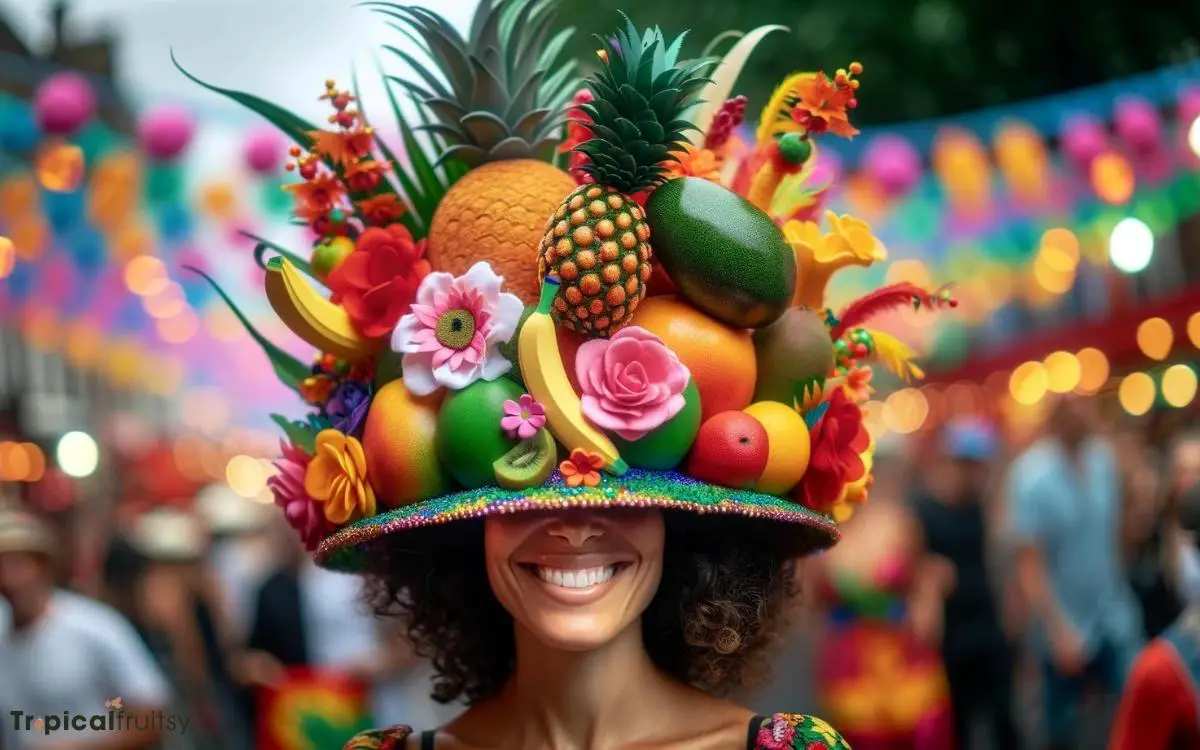
Key Takeaway
Gathering Necessary Materials
Once you have selected your fruits, the next step is to assemble the essential materials, including a sturdy hat base, hot glue gun, and various adhesives, to ensure your tropical fruit creation is both secure and wearable.
The base should be a comfortable yet firm foundation upon which your fruit tableau will rest; think of a broad-brimmed sunhat or a robust beanie for ample surface area and support.
Your hot glue gun will serve as the primary tool for affixing the fruits, so ensure it’s prepped and ready with plenty of glue sticks at hand.
Select adhesives that are both strong and safe for contact with the skin. Consider also gathering scissors, floral wire, and tape for reinforcing structures and shapes within your edible ensemble.
Step 1: Choosing Your Fruits
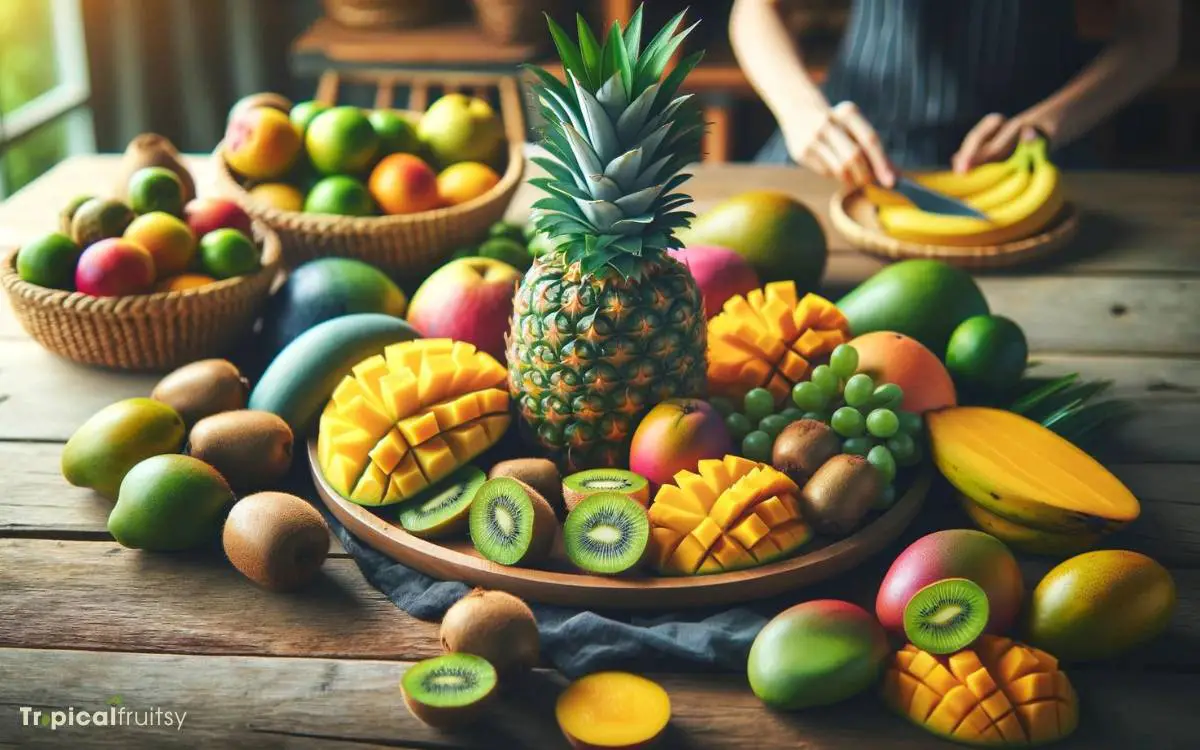
Selecting the appropriate fruits is essential for creating an aesthetically pleasing and structurally sound tropical fruit hat.
Imagine a canvas where each fruit is a vibrant splash of color, a texture, a shape that contributes to a harmonious masterpiece atop one’s crown.
Begin with sturdy, lush bases such as bananas or pineapples, which provide structural integrity. Intersperse with succulent mangoes, papayas, and kiwis, their rich hues painting a tropical dreamscape.
Accentuate with bursts of citrus—lemons, limes, and small oranges—adding zesty highlights. Berries can be jewel-like adornments, offering delicate contrast.
Consider weight and balance, as the composition should be as comfortable as it is captivating. Choose fruits that not only dazzle the eye but also endure the event’s duration, ensuring your wearable art remains as fresh as your creative vision.
Step 2: Designing Your Hat Base
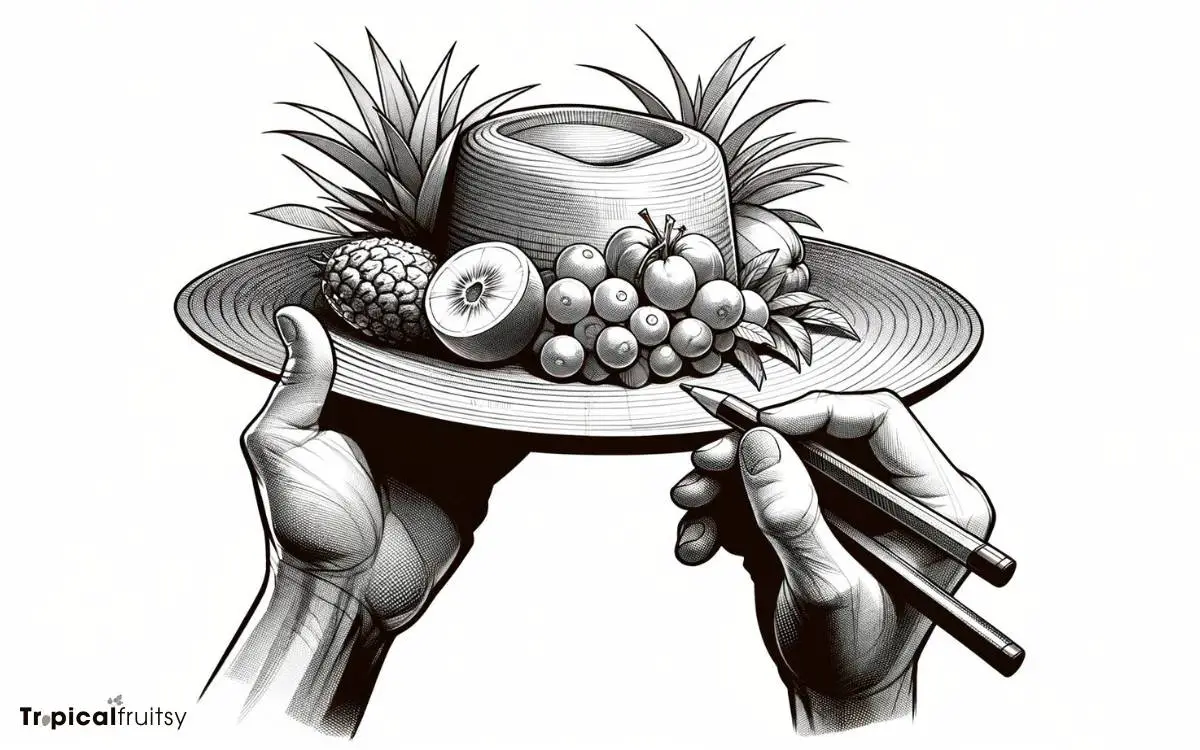
Typically, the design process begins with evaluating the hat base’s shape and size to ensure it can comfortably support the weight and arrangement of the tropical fruits.
The foundation must not only be sturdy but also aesthetically pleasing, as it serves as the canvas for your vibrant creation.
Consideration of the following elements is crucial:
- Structure: Opt for a firm, well-shaped base that maintains form under the fruit’s weight.
- Comfort: Ensure the base fits snugly without causing discomfort.
- Material: Choose materials that are both lightweight and resilient.
- Proportions: Balance the hat’s dimensions with the wearer’s head size.
- Attachment Points: Plan for secure spots to affix the fruits without damaging the base.
A harmonious blend of functionality and artistry will result in a hat base that is both wearable and enchanting.
Step 3: Attaching the Fruit Securely
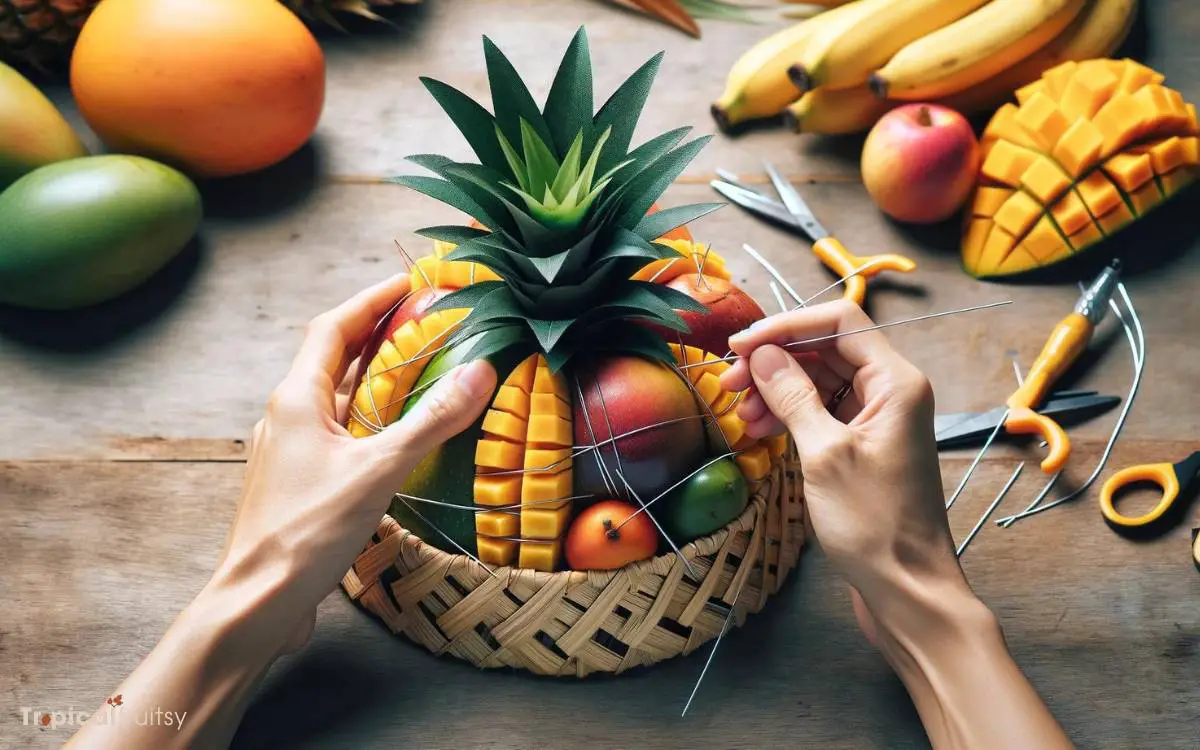
The artistry of your tropical fruit hat hinges not only on the vibrant selection of fruits but also on their steadfast attachment, ensuring a creation that is both enchanting and enduring.
Selecting a robust adhesive becomes the silent yet pivotal ally in affixing each piece with a craftsman’s precision, preventing the untimely descent of your edible ornaments.
Reinforcement techniques, when applied with finesse, can transform your hat from a mere visual delight into a structural masterpiece worthy of any carnival parade.
Selecting Strong Adhesives
To ensure the fruit adheres firmly to the hat, selecting a high-strength adhesive suitable for both the material of the hat and the weight of the fruit is essential.
In the realm of millinery and tropical opulence, the bond between adornment and canvas must be unyielding.
Here are the adhesives that promise a lasting embrace:
- Epoxy Resins: Renowned for their formidable bond, even under the duress of tropical climes.
- Hot Glue Guns: Offering quick setting times and robust adhesion, ideal for swift creations.
- Fabric Glue: Crafted for textiles, ensuring a secure attachment without damaging the hat’s fibers.
- Spray Adhesives: Providing an even coat and reliable hold, perfect for lightweight fruit arrangements.
- Contact Cement: Known for its durability, it adheres strongly to a variety of materials.
As the adhesive sets the stage for permanence, we turn our gaze to reinforcement techniques to fortify our tropical masterpiece.
Reinforcement Techniques
Reinforcement strategies are paramount when securing the fruit to ensure the hat’s structural integrity throughout its use.
Imagine weaving a tapestry of vibrant colors, each fruit representing a thread that must hold fast against the movements of the wearer.
To achieve this, one may employ a variety of techniques, each tailored to the fruit’s character and weight.
Thin wire can be used to create a substructure, like the frame of a delicate sculpture, onto which lighter fruits are affixed, ensuring they dance but do not fall.
For heavier selections, consider using a mesh base attached to the hat, onto which the fruit is threaded or tied, providing a robust foundation.
It’s a balancing act of aesthetics and practicality, where the fruit must be as securely tethered as it is tantalizing to the eye.
Step 4: Decorating With Additional Flair
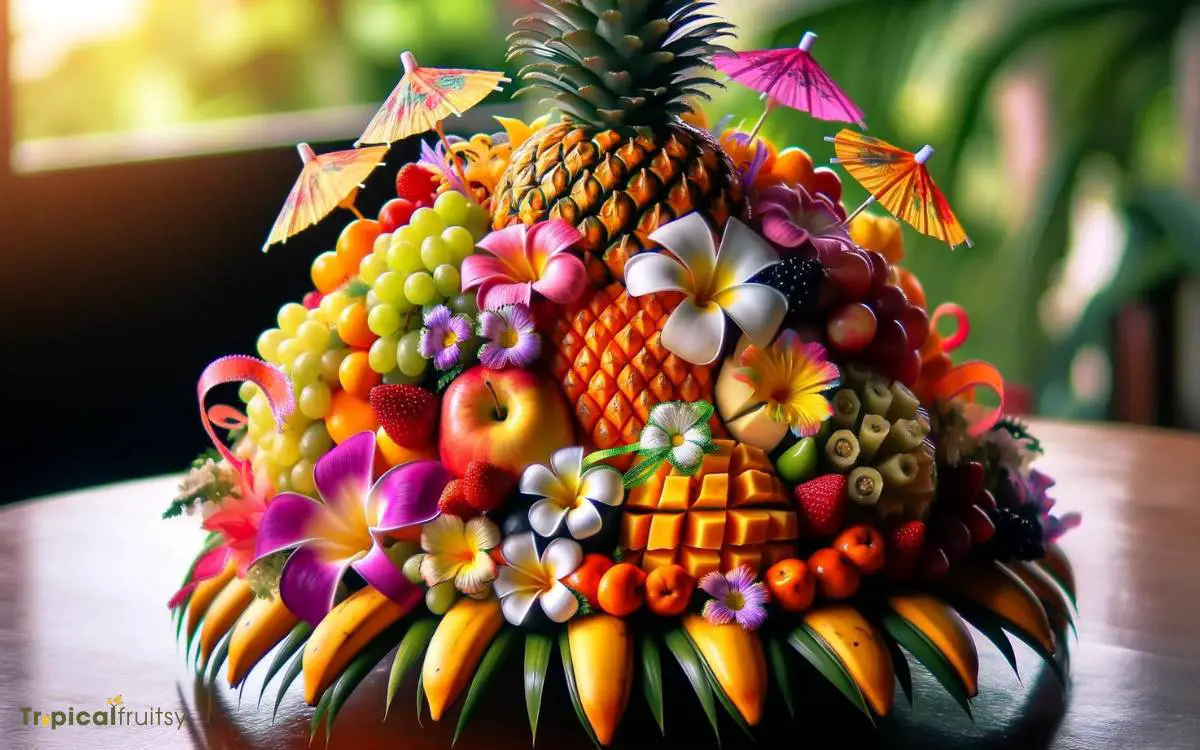
Once the vibrant fruits are affixed in a harmonious tableau, the next phase beckons: elevating the hat’s allure with the incorporation of feather accents.
These plumes, selected for their lustrous hues and sumptuous textures, introduce an element of dynamic movement, catching the light and the eye with every graceful tilt of the head.
Sparkly embellishments, meticulously chosen for their ability to refract light, can be interspersed amongst the feathers to add a scintillating touch, ensuring the hat not only embodies the essence of the tropics but also shimmers with a life of its own.
Feather Accents
Incorporating feather accents can elevate your tropical fruit hat, adding a touch of elegance and movement to the design.
Feathers can mimic the exotic appeal of tropical birds, creating a harmony between the vibrant fruit elements and the soft, delicate textures of the feathers.
When selecting feathers, consider the following to enhance your creation:
- Choose vibrant colors: Select feathers that complement or contrast with the fruit colors for a cohesive look.
- Vary the lengths: Mixing long, sweeping plumes with shorter feathers adds depth.
- Consider placement: Strategically position feathers to create a sense of balance and flow.
- Secure attachment: Use a glue gun or floral wire to ensure feathers stay in place.
- Add a natural curve: Gently shape feathers to mimic the natural curvature of your hat for an organic feel.
A well-adorned hat becomes not just a headpiece but a work of art, capturing the essence of a tropical paradise.
Sparkly Embellishments
To further enhance the visual impact of your tropical fruit hat, consider adding sparkly embellishments for a touch of glamour and sophistication.
Seek out the shimmering allure of sequins, the iridescent play of rhinestones, or the subtle glint of fine glitter.
These elements act as the sun to your hat’s tropical grove, catching the light and casting a spectrum of dazzling reflections that mimic the dew on fresh fruit.
Carefully apply these sparkling treasures with a deft hand, arranging them to accentuate the hat’s contours and the natural beauty of the fruit.
Each piece should be positioned to complement the overall design, ensuring that your tropical fruit hat isn’t just a headpiece, but a wearable work of art that radiates with every turn.
Step 5: Preserving Your Fruit Hat
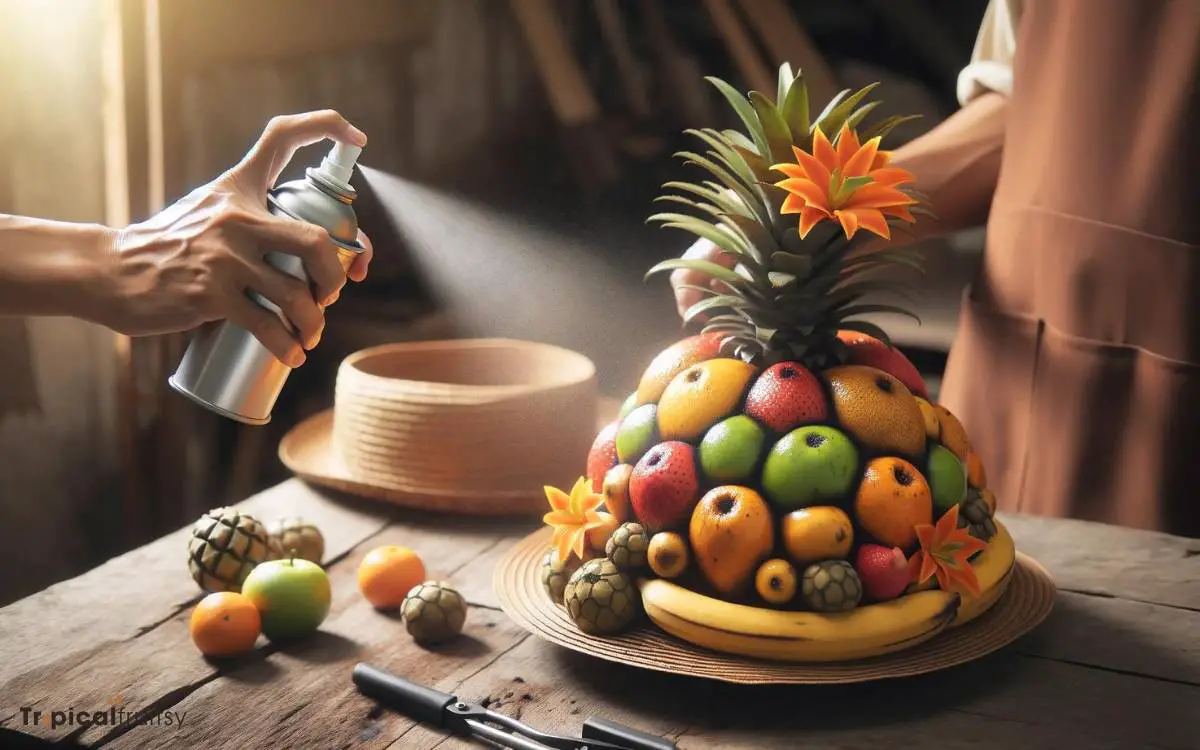
After crafting your tropical fruit hat, it is essential to consider methods for preservation to maintain its vibrant appearance. Embarking on this journey, one must treat the wearable art with the tender care it deserves.
Here are a few artistic strokes to keep the colors bright and the textures inviting:
- Seal with a clear acrylic spray: to add a protective layer against moisture.
- Store in a cool, dry place: away from direct sunlight to prevent fading.
- Use silica gel packets: to absorb any excess moisture.
- Incorporate artificial fruits: for elements that remain perpetually ripe in appearance.
- Regular dusting: to keep each piece looking fresh and lively.
Having woven these preservative measures into the fabric of your creation, let us transition seamlessly into the art of wearing and caring for your hat.
Can I Use the Same Steps to Make a Tropical Fruit Hat to Make a Pineapple Palm Tree Display?
Yes, you can use the same steps to make a tropical fruit hat to create a stunning pineapple palm tree display. With some creativity and the right materials, you can turn a simple idea into an eye-catching centerpiece for any event or party. Try it out and amaze your guests!
Step 6: Wearing and Caring for Your Hat
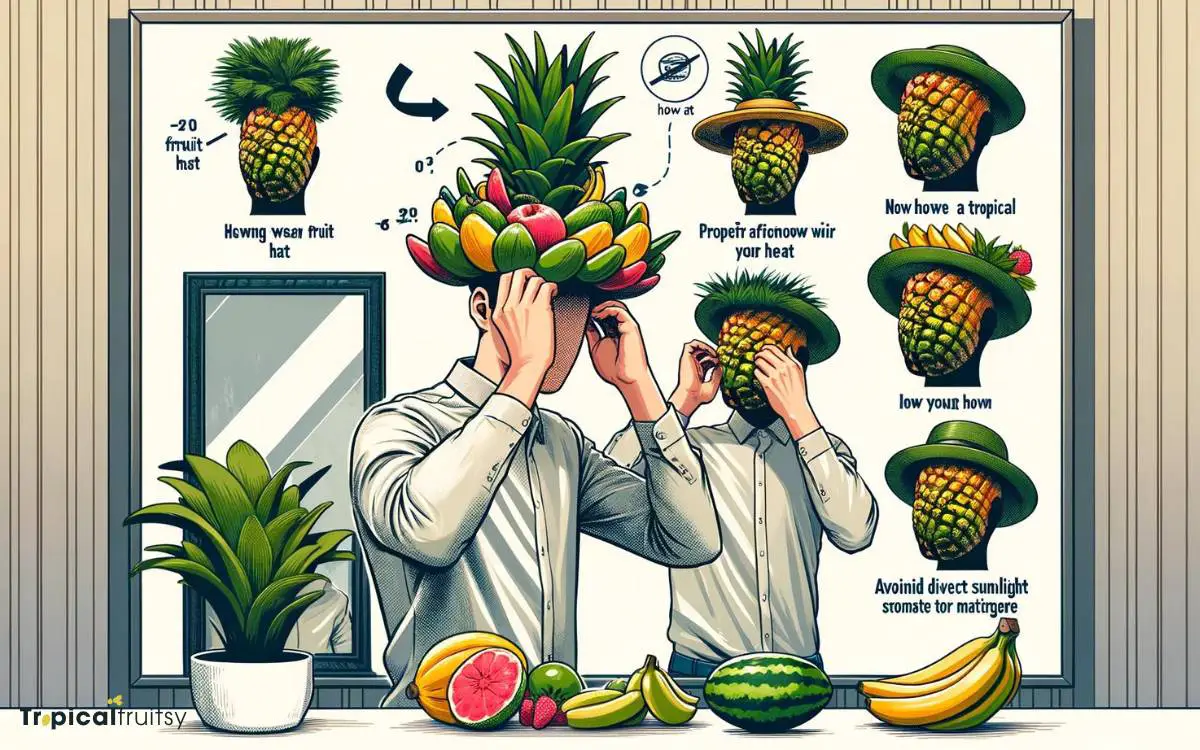
Adorning your head with the tropical fruit hat requires mindful practices to ensure its longevity and aesthetic appeal.
As you balance this vibrant cornucopia atop your crown, consider the symphony of colors and textures that you are showcasing.
To maintain the hat’s splendor, handle it with delicate grace. Avoid the harsh touch of the elements; a sun too bright or a rain too heavy could compromise the intricate artistry.
When wearing your hat, do so with pride and care, understanding that it is not merely an accessory, but a masterpiece of creative expression.
After each use, check for any signs of wear or damage and address these immediately to preserve the hat’s structural integrity.
Store your tropical treasure in a cool, dry place, away from direct sunlight, to cherish its beauty for future festivities.
Conclusion
Crafting a tropical fruit hat is akin to painting a vibrant still life atop one’s head. With judicious selection of fruits, meticulous material preparation, and a robust base as the canvas, each component is affixed with precision.
Ornamentation breathes life into the creation, while preservation techniques ensure enduring splendor.
Such a hat, when donned, becomes more than a mere accessory; it is a celebration of color and creativity, a masterpiece of wearable art.






